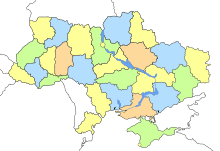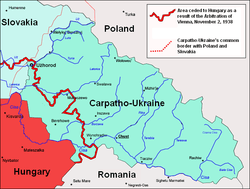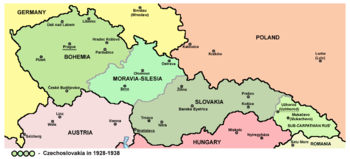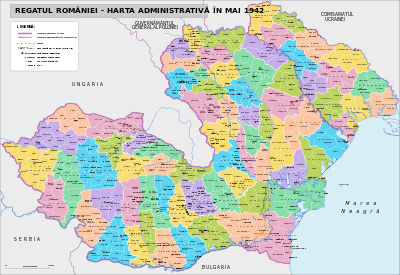Development of the administrative divisions of Ukraine
Administrative divisions development in Ukraine reviews the history of changes in the administrative divisions of Ukraine, in chronological order.
| Part of a series on the |
| Subdivisions of Ukraine |
|---|
 |
| First level (regions) |
| Second level (districts) |
| Third level (communities) |
|
| Special case administrations |
|
| Populated places in Ukraine |
| Former subdivisions |
|
| Classification (KOATUU) |
Overview of Soviet Ukraine (1921–91)
During the existence of the Ukrainian People's Republic and the Soviet Ukraine its administration division went through three changes.
- guberniia (governorate), 1919–1925
- zemlia, 1918, not fully realized territorial administrative reform
- subdistrict, 1925-1936
- okruha (district)
- oblast, 1936–1991
- raion and district (border okrug)
Also there existed national raions and national communities (selsoviets). In Ukraine also was established the Moldavian ASSR and later also included Crimean ASSR.
National raions of Ukraine
List of known national raions of Ukraine in the 1920s and ’30s.
Bulgarians
- Blahoyeve (Blahoyeve), today part of Ivanivka Raion (Odessa Oblast)
- Kolarivka (Kolarivka), today part of Prymorsk Raion (Zaporizhia Oblast)
- Vilashanka (Vilshanka), today part of same name raion (Kirovohrad Oblast)
Greeks
- Velykyi Yanisol (Velykyi Yanisol), today part of similar raion Velyka Novosilka Raion (Donetsk Oblast)
- Sartana (Sartana), today part of Illich Raion of Mariupol
- Manhush (Manhush), today part of Pershotraven Raion (Donetsk Oblast)
Jews
- Kalindorf (Kalinindorf) (1927-1941), today part of Velyka Oleksandrivka Raion (Kherson Oblast)
- Novozlatopil (Novozlatopil) (1929-1941), today part of Hulyaipole Raion (Zaporizhia Oblast)
- Stalindorf (Stalindorf) (1931-1941), today part of Sofiivka Raion (Dnipropetrovsk Oblast)
- Part of RSFSR then
- Larindorf (Larindorf) (1935-1939), today Pervomayske Raion (Crimea)
- Fraidorf (Fraidorf) (1930-1939), today part of Rozdolne Raion (Crimea)
Crimean Tatars
- Part of RSFSR then
- Alushta municipality (1930-1944)
- Balaklava Raion (1930-1944)
- Bakhchisaray Raion (1930-1944)
- Sudak municipality (1930-1944)
- Yalta municipality (1930-1944)
- Albat (1935-?)
Poles
- Markhlevsk (Markhlevsk) (1925-1935), today part of Baranivka Raion (Zhytomyr Oblast)
Germans
- Fritz Heckert (Vysokopillya) (1926-?), today part of Vysokopillya Raion (Kherson Oblast) (see de:Kolonie Kronau)
(see Високопілля — селище міського типу, районний центр, Херсонська область, Високопільський район)
- Zeltsi (Zeltsi)
- Karl-Liebknecht (Landau)
- Karl-Marx
- Luxemburg
- Pulinsk
- Rotfront (Waldheim)
- Singtran
- Friedrich-Engels
- Spartakivka (Spartakivka) (see de:Welykodolynske)
- Molochansk (Molochansk), today part of Tokmak Raion (Zaporizhia Oblast)
- Part of RSFSR then
Before World War II


In 1919, the northern Mhlyn, Novozybkiv, Starodub, and Surazh counties of Chernihiv Governorate, with their mixed Ukrainian–Belarusian–Russian population, were transferred from Ukraine to the newly established Gomel Governorate of the Russian republic.[1] In February 1924, Tahanrih and Shakhtinsky counties (okruhas) were transferred from the Donetsk guberniya of the Ukrainian SSR to the North Caucasus krai of the Russian SFSR.[2][3]

Just before World War II, Hungary with the help from Poland occupied the Carpatho-Ukraine that was to secede from the falling apart Czechoslovakia after the Munich agreement plus some additional territoroes of Slovakia. Poland in turn also occupied some territories of Silesia.
In the fall of 1938, the southwestern territories of Subcarpathian Rus including the cities of Uzhhorod, Berehove, and Mukacheve were yielded to the Kingdom of Hungary.
In 1939, Carpatho-Ukraine was overrun by the Kingdom of Hungary.
Some of the newly acquired territories in 1939 were annexed and incorporated as Kárpátalja. Kárpátalja unlike most of the country, however, had a special administrative system with the intention of it being governed by the Ruthenian minority population. In practice, it was not the case. Kárpátalja was divided into three administrative delegations (közigazgatási kirendeltség) which were each divided into four districts (járás). The previously annexed territories of 1938 were divided into Bereg County and Ung County.
World War II
.png)

In 1939 and 1940, the Soviet Union launched an offensive into eastern Poland and eastern Romania. During these operations, the Ukrainian SSR occupied the territories of Volhynia, Halychyna, Bukovina, and Budjak. In the territories of Volhynia and Halychyna, six oblasts were created in 1939: Lviv Oblast, Drohobych Oblast, Stanislav Oblast, Ternopil Oblast, Volyn Oblast, and Rivne Oblast. In 1940, Bukovina was organized as Chernivtsi Oblast and Budjak as Izmail Oblast.
After the German invasion of 1941, Ukraine was split between three countries Germany, Romania, and Hungary. Within Germany Ukraine also was divided between General Government (Krakau), Reichskommisariat (centered in Rowno), and Wehrmacht administration closer to the Eastern Front.
General Government
The western Ukraine around Lviv was part of the General Government as Distrikt Galizien which was added to already existing four other districts with the start of the Soviet Great Patriotic War. Distrikt Galizien consisted of 13 land-kreis and one stadtkreis (Lemberg). Some other territories that in 1939 were incorporated within Ukrainian SSR were passed to other Distrikts, mostly Krakau.
Reichskommissariat Ukraine
Most of Ukraine was under a "civil administration" of Reichskommissariat Ukraine with capital in Rowno. Some territories also included former parts of Belarus. Reichskommissariat was divided into five General-bezirke and one Teil-bezirke Taurien (Krim):
- Wolhynien und Podolien (Luzk) - 25 Kreisgebiete,
- Shitomir - 17 Kreisgebiete,
- Kiew - 24 Kreisgebiete,
- Nikolajew - 13 Kreisgebiete,
- Dnjepropetrowsk - 16 Kreisgebiete,
- Krim (Melitopol) - 5 Kreisgebiete.
Each Generalbezirke consisted of several Kreisgebiete which in turn were divided into selsoviets. Krim, however, did not in reality encompass territory of the Crimean peninsula which was under a special jurisdiction of Wehrmacht. Territories of Ukraine (Donets basin and Sloboda Ukraine) also stayed under the Wehrmacht jurisdiction due to a close proximity to front-lines. It was planned to extend the territory of such Ukraine all the way to Volga river adding some other General-bezirke.
Romania

Romania liberated the south-western part of Ukrainian Soviet Socialist Republic from the foreign rule, more specifically the area which today constitutes Odessa Oblast eastward of the Dniester and southern Vinnytsia Oblast, land inhabited mostly by romanians a few centuries ago. Those territories were organized into province of Transnistria. Besides Transnistria, Romania also recovered Budjak (Izmail Oblast) and Northern Bukovina (Chernivtsi Oblast), territories with romanian ethnic majority, which Romania lost in the beginning of World War II.
Polish-Soviet border changes (1944–51)


Between 1944 and 1951 the border between Ukrainian SSR and Polish People's Republic changed a lot. There were at least five territorial transfers.
- October 1944 to Poland were transferred Horynets Raion, Lubachiv Raion, Uhniv Raion, Synyava Raion, and Lyashkiv Raion of the Lviv Oblast.
- March 1945 to Poland also were transferred Bircha Raion, Liski Raion, and western part of Peremyshl Raion with the city of Peremyshl from the Drohobych Oblast.
- May 1948 to Poland was also transferred Medyka Raion of Drohobych Oblast.
- In 1951 Drohobych Oblast yielded Nyzhno-Ustritsa Raion to Poland as well.
- February 15, 1951, several Polish localities were transferred to Ukraine as part of the territorial exchange which formed Zabuzk Raion with seat in Belz, including the city of Krystynopil. Later Zabuzk Raion was reassigned under the Sokal Raion of Lviv Oblast.
Other changes (1944–46)
A new Kherson Oblast was created during the war on March 30, 1944, out of the territories of Mykolaiv Oblast and Zaporizhia Oblast.
Beside a Ukrainian-Polish border exchange on January 22, 1946, the Zakarpattia Oblast was also created out of newly acquired Czechoslovakia territories, where Carpatho-Ukraine had been proclaimed just before World War II.
1954
Big changes in the administrative division in Ukraine took place in winter of 1954.
Besides the transfer of the Crimean Oblast from Russia to Ukraine on February 19, a new oblast was created on January 7, the Cherkasy Oblast, mostly out of the southern raions of Kiev Oblast. Cherkasy Oblast also included some raions of Poltava Oblast and Kirovohrad Oblast.
On February 15 of the same year Odessa Oblast was merged with Izmail Oblast into the new Odessa Oblast. Several raions of the previous Odessa Oblast were transferred to the neighboring Kirovohrad Oblast and Mykolaiv Oblast.
Oblast changes (1954–1991)
Before the fall of Soviet Union in 1992 the Ukrainian SSR consisted of 25 oblasts and two cities of republican subordination, Kiev and Sevastopol.
In 1958 Voroshylovhrad Oblast was renamed Luhansk, then in 1970 back to Voroshylovhrad, and in 1990 once again to Luhansk.
May 21, 1959 Lviv Oblast and Drohobych Oblast were merged into Lviv Oblast
1965 Talalaiv Raion was transferred from the Sumy Oblast to the Chernihiv Oblast
1986 Chornobyl Raion and the city municipality of Prypiat were liquidated and merged with the Ivankiv Raion, Kiev Oblast.
In 1988 the new city of Slavutych was established for victims of the Chornobyl catastrophe, in Chernihiv Oblast. The city was subordinated to the Kiev Oblast.
In 1991 Crimea became an autonomous republic.
Independence (1991—)

Ukraine grandfathered the whole Soviet system of administrative division. Cities of republican significance were transformed into cities with special status. In 1992 Crimean abolished autonomous status and changed its name from ASSR into Republic of Crimea, starting a process of separation and integration with Russia. In 1998 Crimea transformed into the Autonomous Republic of Crimea.
- Oblast of Ukraine: 24
- Raions of Ukraine
- Cities of regional significance
- Cities with special status: 2
- Raions in city
- Autonomous republic: 1
- Raions of Ukraine
- Cities of republican significance
Due to the War in Donbass, the status of civil–military administrations was created in territories of Donetsk and Luhansk oblasts where the respective local government units cannot exercise their constitutionally guaranteed powers.[4]
In 2015 a new administrative unit United territorial communities were created meaning settlement councils, rural councils and a city of district significance can create a new administrative unit.[5] This new administrative unit was created to help the financial and administrate power and independence of rural Ukraine.[5]
See also
- Administrative divisions of the Ukrainian SSR
- Administrative divisions of Ukraine
- Soviet occupation of Bessarabia and Northern Bukovina
- Invasion of Poland
- Chernobyl catastrophe
References
- "Chernihiv gubernia". Encyclopedia of Ukraine. Retrieved 2020-05-28.
- Struk, Danylo Husar (1993-12-15). Encyclopedia of Ukraine: Volume IV: Ph-Sr. University of Toronto Press. ISBN 9781442651265.
- Krinko, Evgeny F. (2015). "'…To Elect a Parity Commission': Documents about the Transfer of Taganrog and Shakhty Districts to the RSFSR in 1924–1925" (PDF). Russkii Arhkiv. 10 (4): 288–295. doi:10.13187/ra.2015.10.288.
- "Poroshenko gave the green light to create civil-military administrations". Ukrayinska Pravda. Ukrainian. 26 February 2015. Retrieved 26 February 2015.
- (in Ukrainian) Elections in the united territorial communities. What is this and what you need, Espreso TV (31 October 2017)